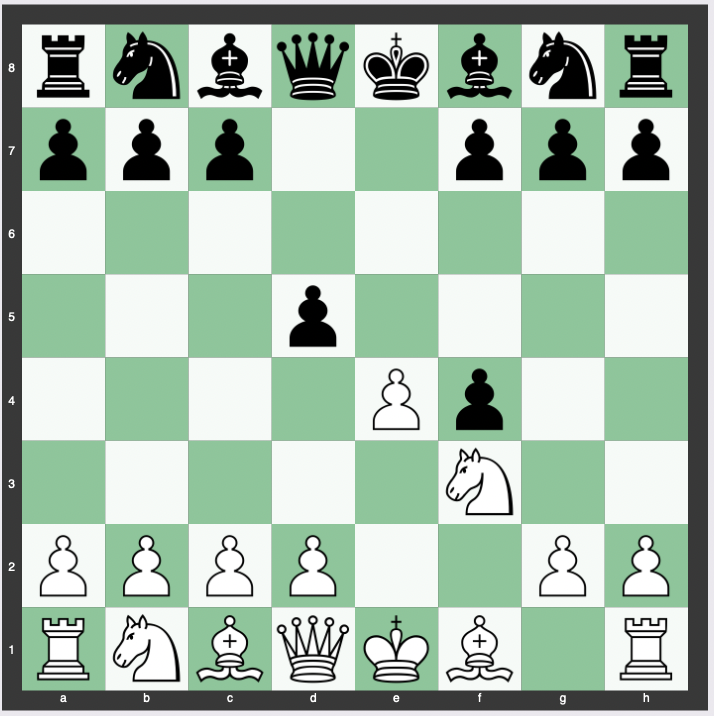One such defense in the King’s Gambit is the Abbazia Defense.
Also known as Modern Defense in the context of the King’s Gambit, the Abbazia Defense is characterized by the moves 3.Nf3 d5.
This defense, while seemingly straightforward, is laced with nuance and potential, offering a dynamic playing field for both Black and White.
This article will delve into the ins and outs of the Abbazia Defense, its impact on game strategy, and the modern perception of this gambit.
History and Basic Idea of the Abbazia Defense
The Abbazia Defense has its roots intertwined with the Falkbeer Countergambit.
Much like the Falkbeer, the Abbazia Defense focuses on increasing piece activity and seizing the initiative rather than retaining the extra pawn.
This has led many players and chess commentators to see the Abbazia Defense as a reliable method to achieve equilibrium, even if at first glance White appears to have an advantage due to an extra central pawn and active pieces.

Transposition
In the language of chess, transposition refers to the practice of reaching a certain position via a different sequence of moves.
The Abbazia Defense can indeed be transposed from the Falkbeer Countergambit through the sequence 2.f4 d5 3.exd5 exf4.
This transposition from the Falkbeer underscores the Abbazia Defense’s flexibility, making it a dynamic tool in a chess player’s repertoire.
Combatting the King’s Gambit with the Abbazia Defense
Key Moves of the Abbazia Defense
If White chooses to capture, with 4.exd5, Black is presented with two viable responses, 4…Nf6 or 4…Qxd5.
Should Black opt for 4…Qxd5, the game effectively morphs into the Scandinavian Variation of the King’s Gambit Accepted (KGA).
The strategic possibilities afforded by the Abbazia Defense come into focus at this juncture, allowing for a variety of tactical choices based on the player’s preferred style of play.
Evaluation of the Abbazia Defense
The Abbazia Defense is generally evaluated at around -0.10 to -0.35 for white.
Theory & Continuation Lines of the Abbazia Defense
Below we have some common theory and continuation lines from the Abbazia Defense starting move order 1. e4 e5 2. f4 exf4 3. Nf3 d5 that you would see at the highest level of play.
4. exd5 Nf6 5. c4 c6 6. Nc3 Bd6 7. dxc6 Nxc6 8. Be2 Bb8 9. d4 O-O 10. O-O Re8 11. Kh1 Bg4 12. d5 Ne7 13. Ng1
4. exd5 Nf6 5. c4 c6 6. d4 Bb4+ 7. Nc3 cxd5 8. Be2 O-O 9. O-O dxc4 10. Bxc4 Nc6 11. Bxf4 Bg4 12. a3 Ba5 13. Kh1 Bxf3 14. Qxf3 Qxd4 15. Bb3 Bxc3 16. Rad1 Qb6 17. Qxc3 Rad8 18. Rxd8 Rxd8
4. exd5 Nf6 5. c4 c6 6. Nc3 cxd5 7. cxd5 Bd6 8. Bb5+ Nbd7 9. Qe2+ Qe7 10. Qxe7+ Kxe7 11. O-O Re8 12. Ng5 a6 13. Bxd7 Bxd7 14. d3 Bf5 15. Nge4 Bxe4 16. dxe4
4. exd5 Nf6 5. c4 c6 6. d4 Bb4+ 7. Nc3 cxd5 8. Be2 Nc6 9. O-O Be6 10. Qb3 dxc4 11. Bxc4 Bxc4 12. Qxc4 O-O 13. Bxf4 Rc8 14. Qb5 Qb6 15. Qxb6 axb6 16. a3 Bxc3 17. bxc3 b5 18. Bg5 Ne4
Modern Defense | King’s Gambit Opening Theory
Conclusion
The Abbazia Defense, a remarkable line in the Modern Defense, offers players a balance of strategic depth and dynamic gameplay.
While it may give White a seeming advantage, the opportunities for Black to create engaging and challenging scenarios are plentiful.
Despite the shift in modern perception that indicates a slight advantage for White, the Abbazia Defense remains an intriguing aspect of chess, a testament to the game’s endless strategic possibilities and captivating complexity.
Whether you’re a seasoned grandmaster or an aspiring chess enthusiast, understanding and utilizing the Abbazia Defense can enrich your appreciation for the intricate beauty of chess.


